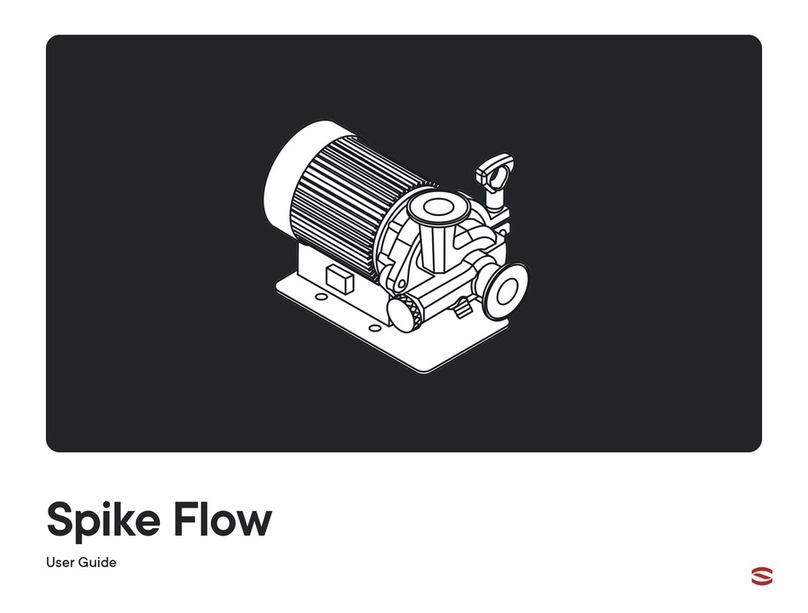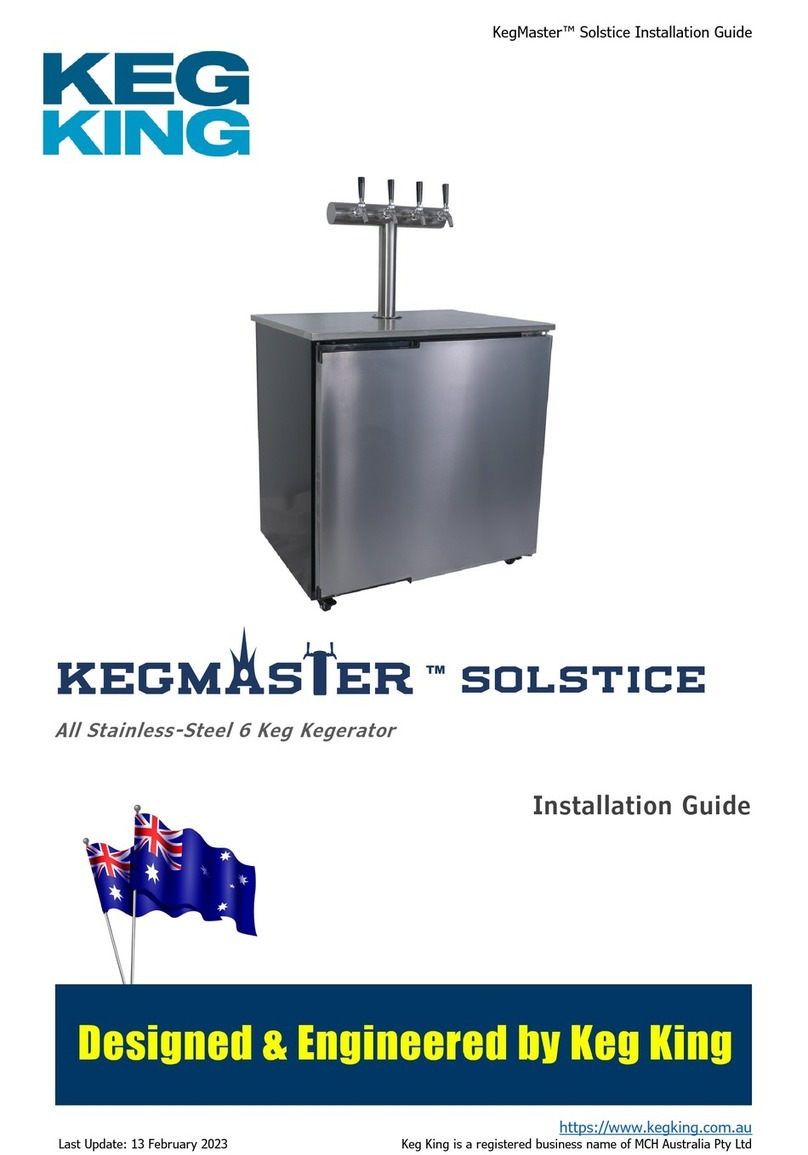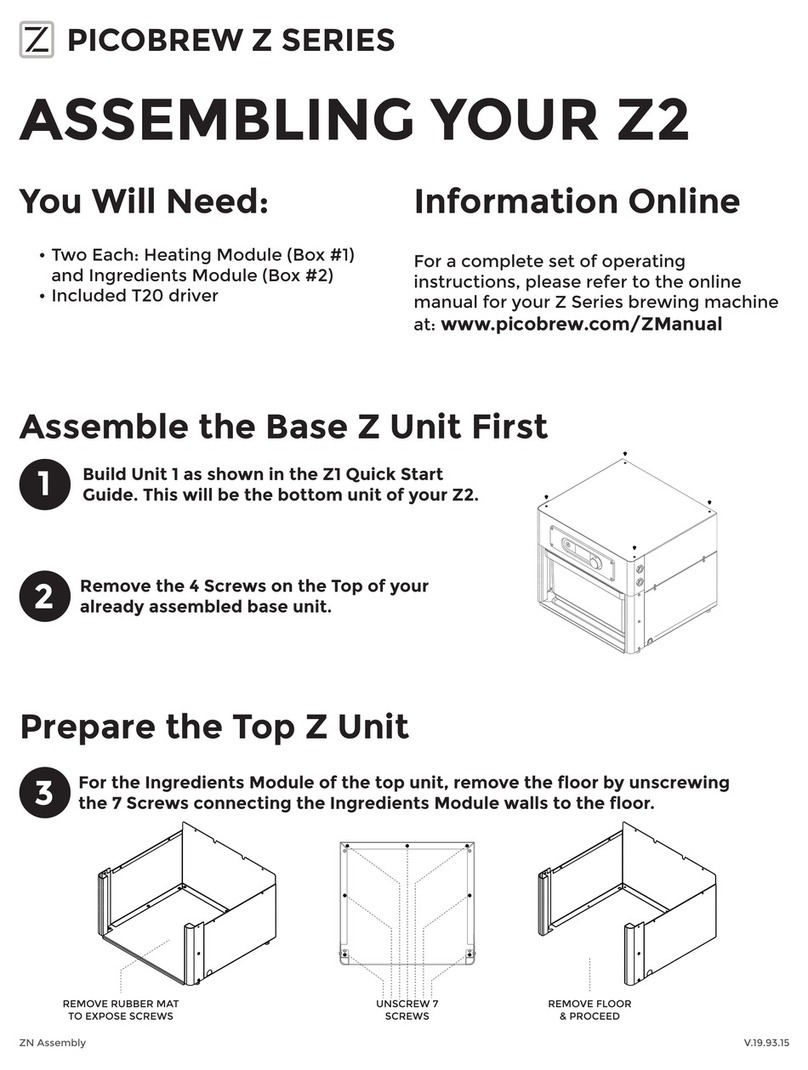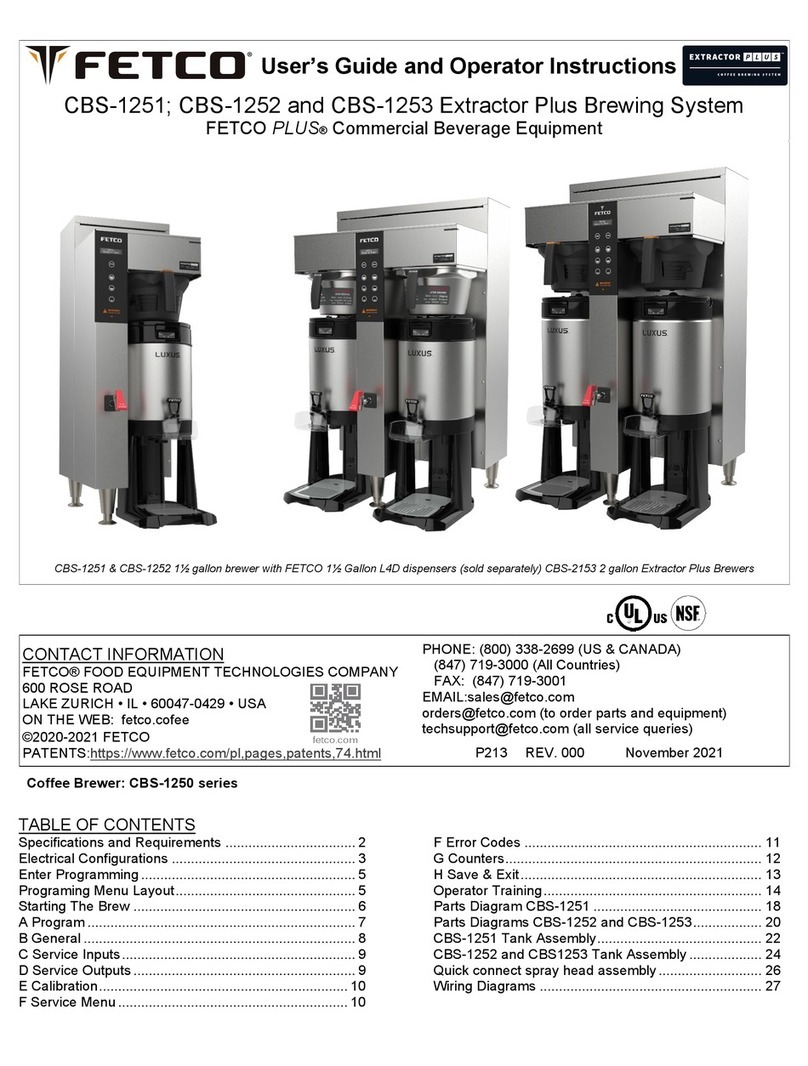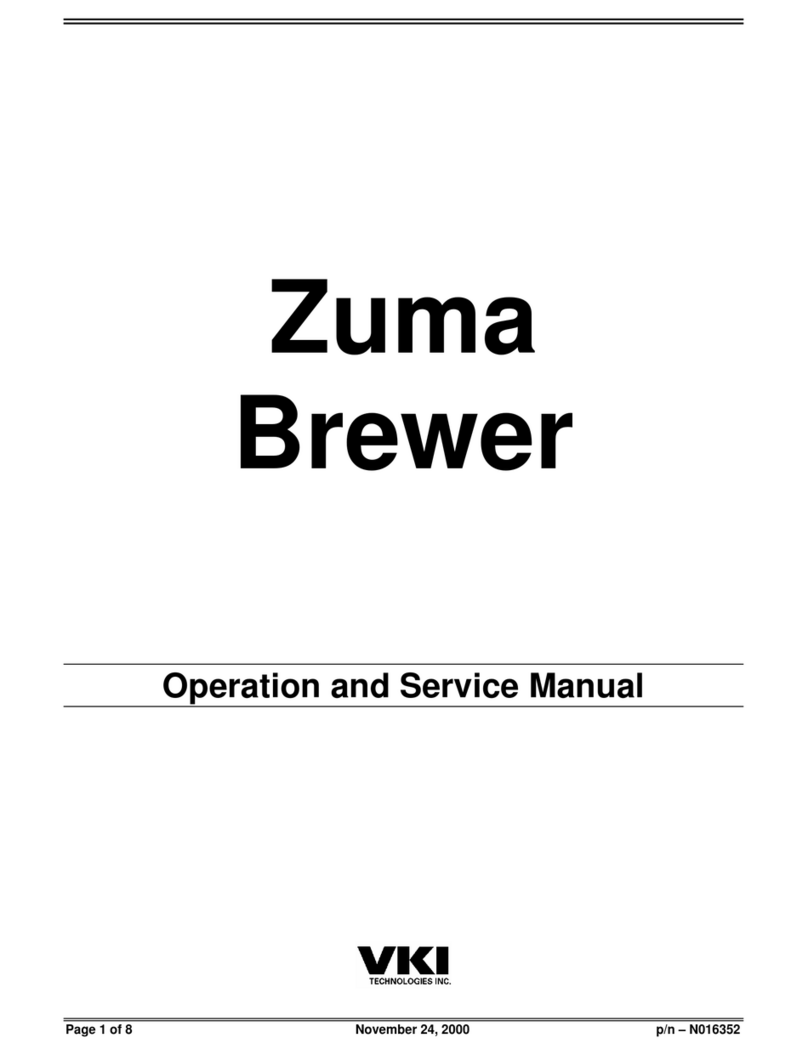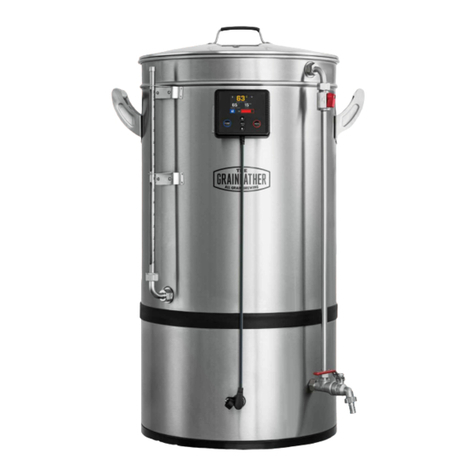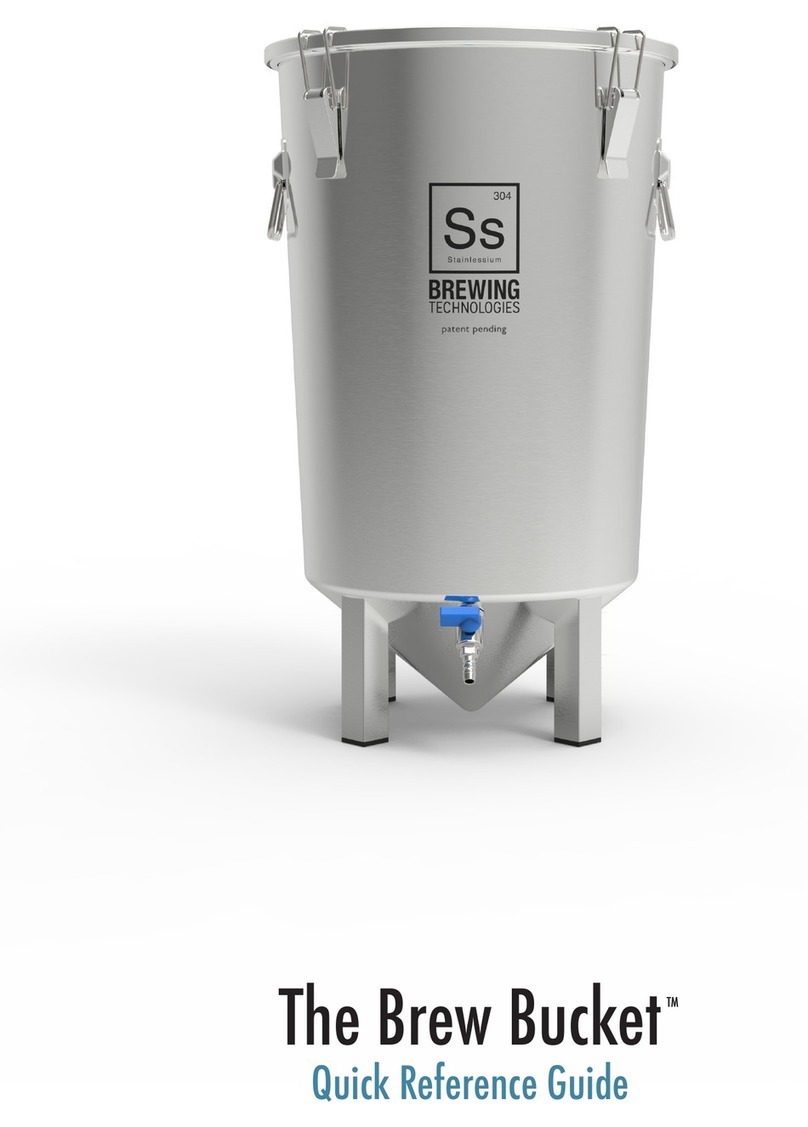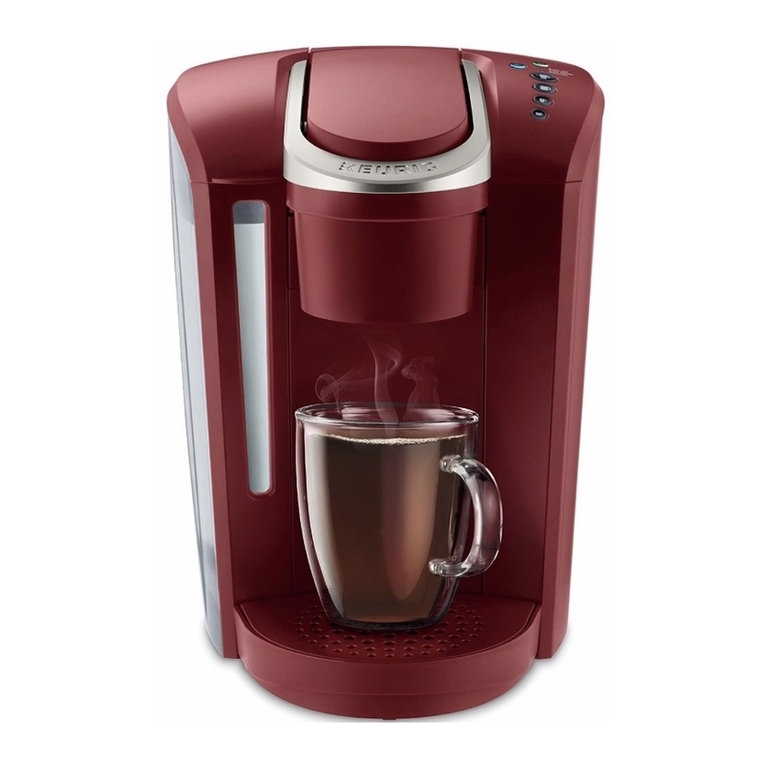BrewBuilt X1 UNI PRO User manual

X1 UNI PRO
ASSEMBLY AND
INSTRUCTION GUIDE
CONTENTS:
PAGE 2–3..............Cleaning, Testing, What’s Included
PAGE 3 – 4...............................................................................Assembly
PAGE 5................................Important Safety Information
PAGE 5–7...........................................General Use & Features
PAGE 8....................................Connecting the Control Panel
PAGE 8...........................................Setting Your Temperatures
BREWBUILT.COM
WARNING
Read entire manual for important
safety information before using
your BrewBuilt X1 Uni Conical
Fermenter. Failure to follow warnings
could result in serious injury or death.

1. Neoprene Jacket
2. Pressure Pack
ALWAY RELEASE PRESSURE from the fermenter
before removing any TC connection, tting,
accessory, or lid clamp connected to the
Fermenter. Read section below on how to release
pressure from Fermenter.
This guide will walk you through assembling
and using your new conical fermenter.
GETTING STARTED
2. CLEAN THE CONICAL
Before your first use, clean and rinse the conical
along with all the parts and fittings. This will remove
any leftover oil or dust from the manufacturing
process. We recommend using PBW cleaner. Do
not use bleach.
3. WATER TEST
After cleaning and rinsing, we also recommend
filling your conical with water and familiarizing
yourself with its operations prior to your first use.
Before you tighten down TC clamps, make sure the
gasket is seated properly into both flanges.
Once the gasket is in place, loosen the clamp so it
can be fitted around the flange ends.
You do not need to use any tools for leverage
when tightening TC clamps. Hand tightening is
enough for a secure, leak-proof connection.
READ AND UNDERSTAND
THIS FULL MANUAL
Before your first use, read through this full manual,
and make sure you understand the use & warnings.
See BrewBuilt YouTube channel for additional
assembly videos.
1.
First Time Working
With TC Clamps?
Additional Parts
Included:
ITEM DESCRIPTION QTY
A Pressure Lid 1
B 4" TC Clamp 1
C 4" TC Gasket 1
D 1.5" Blow Off Barb 1
E Silicone Blow Off Tube 1
F 1.5" TC Clamp 3
G 1.5" TC Gasket 3
H Conical Lid 1
I Lid Clamp 1
J Lid Gasket 1
K Conical Body 1
L 1.5" TC Thermowell 1
M 1.5" TC Sample Valve 1
N 2" TC Gasket 1
O 2" TC Clamp 1
P 2" Butterfly Valve 1
Q Flex Chamber 1
R 3/8" Leveling Foot 4
Parts List
PAGE 2 BREWBUILT.COM
1 2

BREWBUILT.COM PAGE 3
K
F
G
E
D
J
H
I
A
L
F
G
N
O
P
M
F
G
R
B
C
Q
ASSEMBLING FOR ALL X1 CONICALS
FEET
Thread each foot into the bottom of the legs on the Conical leaving about half an inch of thread visible. Adjust as needed.
BLOW OFF
Place 1.5" TC gasket into the open blow o port on the conical lid and fasten the Blowo U Barb with a 1.5" TC clamp, ensuring that the U
Barb is pointing downward o the side of the conical. Slide ½" Silicone tubing over the barbed side of the U Barb. It’s easiest to start with
one side and then work it around until barbs are fully covered.
THERMOWELL
Place 1.5" TC Gasket and Thermowell into the open port in front of the conical just below the etched BrewBuilt Logo and
fasten in place using 1.5" TC clamp.
SAMPLE VALVE
Place 1.5" TC Gasket and Sample Valve into the open port halfway down the conical base on the front of the unit and fasten in place using
1.5” TC clamp. Make sure the Sample Valve is closed by turning it clockwise until it stops.
BUTTERFLY VALVE
The Buttery Valve opens in one direction, so be sure to install it so the valve handle opens downward away from the conical bottom. Place
2" TC Gasket and Buttery Valve on the bottom port of the conical and fasten in place using 2" TC clamp.

`
PAGE 4 BREWBUILT.COM
LID CLAMP ASSEMBLY
Improper assembly of the lid clamp can cause the X1 Lid to be released while under pressure, possibly resulting in injury or death.
•When installing the lid clamp, be careful to install it according to the pictures shown here.
•Ensure that the lid is centered on top of the conical body during assembly. The two should be centered so that the clamp seals down evenly.
•Lid Clamp should be hand tightened fully so there is a 5/8” gap between the ends on the 27 and 42 gallon models and a 1/8” gap on the 7
and 14 gallon models. See assembly pictures below for proper setup.
LID GASKET ASSEMBLY
•Flip the lid upside down and install a section of the gasket, at
side seating into the lid groove rst. Lightly push the gasket in,
installing it in the groove as you go around the lid.
•Please Note, the gasket is larger than the groove to help ensure
a tight seal during fermentation. Continue pushing the gasket
against itself and into the lid until it is in the groove and equally
distributed without stretch points. Once you get the rst piece
of the gasket in the groove then you can use both hands to work
the gasket around the lid and into the groove with your thumbs.
WARNING
GASKET
ORIENTATION
Flat Side Into Lid Groove
GASKET INSTALLATION
With Lid Upside Down, Push Flat End Of
Gasket Into Lid Groove
Improper assembly of the lid clamp can
cause the X1 Lid to be released while
under pressure, possibly resulting in
injury or death.
Correct Lid Clamp Assembly for 27 and 42 Gallon X1
Incorrect Lid Clamp Assembly: Backwards Arm
Incorrect Lid Clamp Assembly: Partial Engagement
Incorrect Lid Clamp Assembly: Rotated Arm
TOP VIEW
Top View
Top View
Top View
Side View
Side View
Side View
FULL
ENGAGEMENT FULL
ENGAGEMENT
FULL
ENGAGEMENT
FULL
ENGAGEMENT
CORRECT GAP
OF 1/8"
CORRECT
GAP
OF 1/8"
CORRECT
GAP
OF 5/8"
CORRECT GAP
OF 5/8"
CORRECT ARM
ROTATION
CORRECT ARM
ROTATION
CORRECT
ARM ROTATION
CORRECT
ARM ROTATION
INCORRECT
ARM ROTATION
BACKWARDS
ARM
PARTIAL
ENGAGEMENT
ARM
ROTATED
CORRECTLY BUT
NOT FULLY ENGAGED
IN SADDLE
Correct Lid Clamp Assembly for 7 and 14 Gallon X1

`
SANITIZE Always sanitize your Conical before lling it with wort.
This includes opening your sample valve and dump ports to ensure
sanitizer makes contact with every nook ‘n cranny. We recommend
Star San or a similar sanitizer. Never use a bleach solution as bleach will
cause pitting and corrosion on the surface of the stainless steel.
FILLING — Your conical can be lled by dumping wort through the
top, or pumped in via the sample valve.
Do not overll your conical past the maximum
volumes listed below. Excess volume during fermentation can cause
fermentation material called Krausen to clog the blow o and airlock
causing over-pressurization of the conical to occur.
MAXIMUM FILL LEVELS:
•7 Gallon X1 – 5.5 gallons liquid
•14 Gallon X1 – 11 gallons liquid
•27 Gallon X1 – 21.5 gallons liquid
•42 Gallon X1 – 33 gallons liquid
FERMENTATION — With the blow o barb and silicone blow o
hose connected, place the end of the silicone blow o tubing into a
bucket lled with water. We prefer the silicone tubing as opposed to
a rigid stainless blow o as silicone tubing is much easier to remove
and clean between batches. Silicone also allows greater exibility with
regards to blow o location.
During fermentation, never close o/cap your X1
except when using the BrewBuilt Pressure Fermentation Kit.
If you wish to add pellet hops, whole hops, oak, or any other loose
material to the fermentation we recommend using a mesh bag. Boil
the mesh bag before use to ensure sanitization.
Do not place pellet hops, whole hops, oak chips, or
other items directly into the fermenter. Loose material can clog the
blow o and airlock causing over-pressurization of the conical to occur.
Use a mesh bag to contain these types of materials.
TEMP CONTROL — Controlling your fermentation temperature is
one of the most important things you can do to make better beer.
There are several options for temperature control. One option is to
place your Conical in a temp controlled environment. The easiest way
to do this is by using a refrigerator that is hooked up to a temperature
controller, eectively turning it on and o as needed to maintain your
set point. Or you can build your own fermentation chamber using
GENERAL USE
BREWBUILT.COM PAGE 5
IMPORTANT SAFETY INFORMATION
Please read this entire instruction manual for important safety information prior to the use of your BrewBuilt X1 Uni Conical Fermenter.
GENERAL PRECAUTIONS
•Follow all instructions and warnings provided with cleaning agents when cleaning and sanitizing Fermenter.
•Do not pick up Fermenter when full; it is heavy and the handles are not designed to safely li a full Fermenter.
PRESSURE HAZARDS
If sealed, the fermenter can be pressurized due to the production of CO2in fermentation or the introduction of compressed gas. When the
Fermenter is pressurized, incorrect use can lead to a risk of the lid or ttings being launched with great force and causing serious injury or death.
To reduce this risk, follow these precautions to safely pressurize and release pressure, and to prevent unintentional pressurization:
•Before removing the lid clamp, TC (Tri-Clamp) ttings, or accessories, release all pressure by opening the Pressure Relief Valve (PRV) .
•Do not overll your conical past the maximum volumes listed below. Overlling can cause fermentation material called Krausen to clog the
blow o and airlock.
•Do not place pellet hops, whole hops, oak chips, or other items directly into the fermenter. Loose material can clog the blow o and airlock.
Use a mesh bag to contain these types of materials.
•Do not alter or change the Pressure Relief Valve (PRV) built into the lid.
•Pressurize with compressed gas only with the Pressure Pack with Clear Float Technology. Always use an approved CO2regulator, with a
functional low-pressure gauge. Never exceed 15 PSI.
•Do not seal/cap an actively fermenting beer, except when using the BrewBuilt Kit for Fermenting Under Pressure.
•When the optional BrewBuilt Flex Chamber is installedalways keep the bottom buttery valve open, allowing CO2to be released. Failure to
keep the valve open couldcause the Flex Chamber to become over pressurized and explode.
ELECTRICAL WARNINGS:
To reduce the risk of re or electrical shock, follow these warnings.
•Always use a GFCI outlet rated at 15amps/110v/60z.
•The GFCI will not supply power without a proper ground.
•Do not use if there is any damage to the wiring.
•Do not spray or immerse the control panel. To clean wipe with a damp cloth when unplugged.
Failure to follow these warnings could result in serious injury or death.

TIP: If you are connecting the Flex Chamber to a full X1 conical, it’s
important to understand some basic displacement concepts. The
empty Flex Chamber is lled with gas (oxygen) that will be sent
up through your beer. If this happens post fermentation it could
negatively impact the beer’s avor. See below to learn how to use
your Flex Chamber side ports to ush with CO2.
COLLECTING & DUMPING TRUB WITH FLEX CHAMBER
The ability to remove trub and hop sediment is one of the key
advantages of a conical fermenter. With the buttery valve open
and the Flex Chamber attached, trub separates directly into the Flex
Chamber, which can then be easily removed. Follow the process
outlined below.
1. If you are using the conical with the Pressure Pack lid, make sure
the entire conical system has been depressurized and that the
bottom buttery valve is in the open position. For instructions
on releasing pressure see the section below titled “Releasing
Pressure”.
2. When you are sure the system has been depressurized, close the
buttery valve at the bottom of the conical.
3. Place a bowl or small bucket below the Flex Chamber to collect
drips and un-clamp the Flex Chamber from the buttery valve.
FLUSHING THE FLEX CHAMBER WITH CO2
An optional step is to ush your Flex Chamber with CO2prior to
attaching it. This will help eliminate oxygen from the Flex Chamber.
You can easily do this by attaching a ball lock adapter (Part# KG500)
to one of the threaded side ports. Here’s how to eectively ush
the Flex Chamber with CO2.
1. Soak or spray the Flex Chamber and all parts — caps, gaskets,
clamps, etc. — with sanitizer prior to assembling and attaching it to
your conical dump port.
2. Attach the Flex Chamber to the bottom of the buttery valve,
keeping the buttery valve closed. Remove one black side cap
and install the KG500 ball lock adapter. Slightly loosen the other
black cap on the opposite side of the Flex Chamber so that CO2
can escape while ushing.
3. Set the regulator on your CO2tank to its lowest possible setting,
i.e. 1–2 psi, and connect your Ball Lock Gas QD to the KG500 ball
lock adapter.
4. Allow gas to ow out of the Flex Chamber for a few seconds to
ensure all the oxygen has been ushed. Tighten the black cap.
You can replace the KG500 with the black cap or leave it in place
for fermentation.
Pressure Package
If sealed, the fermenter can be pressurized due to the production of
CO2in fermentation or the introduction of compressed gas. When
the Fermenter is pressurized, incorrect use can lead to a risk of the
lid or ttings being launched with great force and causing serious
injury or death. To reduce this risk, follow these precautions to
safely pressurize and release pressure, and to prevent unintentional
pressurization:
•Before removing the lid clamp, TC (Tri-Clamp) ttings, or
accessories, release all pressure by opening the Pressure Relief
Valve (PRV) .
•Do not overll your conical past the maximum volumes listed
below. Overlling can cause fermentation material called
Krausen to clog the blow o and airlock.
•Do not place pellet hops, whole hops, oak chips, or other items
insulation and an AC unit. The downside of these options is they
require more space and take longer to cool since it’s cooling the
fermenting wort from the outside in. Either way, your BrewBuilt
Conical comes with a Thermowell that allows you to insert the
temperature probe from a temp controller, which will monitor your
fermentation temp and power on the fridge or AC unit whenever
chilling is needed.
For the ultimate in fermentation temperature control, upgrade
to a BrewBuilt CoolStix & Neoprene jacket along with a BrewBuilt
IceMaster Glycol Chiller. Learn more about using a CoolStix in the
X1+ section at the end of this manual.
DUMPING YEAST AND TRUB — One of the biggest benets
of a Conical Fermenter is the ability to dump yeast & trub from the
bottom port. This couldn’t be easier with the 2” TC Buttery Valve
on the bottom of your conical. Another added advantage is being
able to harvest your yeast for use in future batches. Regardless of
whether you’re dumping trub, hops, or yeast, you will want to guide
that slurry into a drain or receiving vessel like a bucket or jar. Be sure
to spray the Buttery Valve down with sanitizer prior to dumping.
Also, keep in mind that you will need to open one of the ports on
the top of the conical to allow air to replace the liquid that is owing
out the bottom. Another option is the BrewBuilt Flex Chamber that
connects to the bottom of the conical and allows you to collect and
dump yeast and trub. Learn more about using the Flex Chamber in
the X1+ section of this manual.
TRANSFERRING FINISHED BEER — Racking your beer with
the sample port is as easy as hooking up some sanitized tubing and
opening the valve. Remember that you will need to either open
one of the ports on the top of the conical to allow air to replace
the liquid that is owing out. To transfer out of your X1 using CO2
pressure see the section under Pressure Package below.
The Flex Chamber
•When the optional BrewBuilt Flex Chamber is installedalways
keep the bottom buttery valve open, allowing CO2to be
released. Failure to keep the valve open couldcause the Flex
Chamber to become over pressurized and explode. When
you are ready to remove the Flex Chamber, depressurize the
system with the buttery valve open. This allows any pressure
to also leave the Flex Chamber. Aer relieving all pressure in
the system you can close the buttery valve and safely remove
the Flex Chamber.
The Flex Chamber is designed specically for
use with a BrewBuilt X1 conical Fermenter.
It attaches directly to the 2" buttery dump
valve and can be used for removing trub,
harvesting yeast, and many other tasks.
PREPARING YOUR FLEX CHAMBER FOR
USE EACH TIME
1. Soak or spray the Flex Chamber and all parts with sanitizer
prior to assembling and attaching it to your conical dump port.
2. Assemble your Flex Chamber by attaching the lid and threading the
caps onto the threaded ports on each side.
3. Spray sanitizer into the closed buttery valve on your conical
dump port as well as the top of the Flex Chamber and its TC
gasket. Fasten the Flex Chamber to the buttery valve with a 2”
TC clamp.
PAGE 6 BREWBUILT.COM

directly into the fermenter. Loose material can clog the blow o
and airlock. Use a mesh bag to contain these types of materials.
•Do not alter or change the Pressure Relief Valve (PRV) built into
the lid.
•Pressurize with compressed gas only with the BrewBuilt Kit
for Fermenting Under Pressure. Always use an approved CO2
regulator, with a functional low-pressure gauge. Never exceed
15 PSI.
•During fermentation, never close o/cap your X1 except when
using the BrewBuilt Kit for Fermenting Under Pressure.
•When the optional BrewBuilt Flex Chamber is installedalways
keep the bottom buttery valve open, allowing CO2to be
released. Failure to keep the valve open could cause the Flex
Chamber to become over pressurized and explode.
The Pressure Pack, specically designed to work
with BrewBuilt X1 Conical Unitanks, unlocks many
possibilities. Apply low pressure before cooling to
eliminate sucking oxygen back in. Use it to grab a sample
or transfer nished beer to a keg in a true oxygen-
free environment. The Clear Float allows sampling or
transferring of the clearest possible beer from
the top down! In this guide. Please read and
follow the additional instructions that come
with your Pressure Pack Kit.
INSTALLATION
Assemble the Pressure Pack lid per the
diagram. DO NOT USE TEFLON TAPE to
assemble threaded body connects as
they seal with the included o-rings. When
attaching the Pressure Pack lid to your X1
conical, be sure your TC gasket is properly
seated and then tighten down the TC clamp.
Follow instructions that come with your
Pressure Pack lid.
TIP: A welded a hook on the bottom of the
Pressure Pack Lid can be used to hang drawstring
bags for avoring additions.
APPLYING PRESSURE
FIRST TEST —First take a moment and read the warnings above. For
safety we always recommend the rst pressure test be made while
the conical is lled with water. Aer the conical is completely lled
with water, replace the u-shaped blowo with an included TC end
cap. Before connecting CO2pressure be sure you have a working,
accurate regulator with a low pressure gauge. We recommend
setting your regulator to 1–2 psi to start with, and always less than
15 psi. Connect your gas-in ball lock QD on your CO2dra system
to the gas-in body connect located on the Pressure Pack. The gas-
in body connect has a notch on the side, while the beverage-out
body connect does not. With 1-2 psi applied to the conical, practice
releasing pressure by unthreading the PRV cap. Read the section
on releasing pressure slowly as instructed in the section ‘Releasing
Pressure’ below.
TRANSFERRING AND SAMPLING
The bev-out tting is equipped with a unique oating dip tube that
will pull beer from the top rather than the middle or bottom of the
conical. We recommend using a ball lock jumper, a section of beer
line with a beverage-out QD at both sides, to transfer beer from
your X1 to the bottom of your keg. When applying pressure for
sampling or transferring start with a low pressure and increase only
as needed. Keep in mind that your X1 Uni and Pressure Pack lid are
rated at 15 psi and the PRV will start releasing pressure around this
point. Never apply more than 15 PSI to your X1.
TIP: Filling your keg from the bottom up will keep splashing to a
minimum as beer will ow down the beverage dip tube and gently
ll the keg from the bottom up. Lastly, pull up the PRV ring on the
keg and set it in the open position to allow air (or CO2if you pre
purged the keg) to escape as your fresh beer ows in.
RELEASING PRESSURE
Before removing the lid clamp, TC tting, or
any accessory, you must rst release any pressure from your
BrewBuilt Fermenter.
Releasing pressure from your X1 can be achieved by loosening the
cap on the Pressure Relief Valve (PRV) that is built into the lid. Slowly
loosen the cap counterclockwise until you hear the release of any
CO2exiting the PRV. When the release has stopped, continue to
slowly unthread the cap. At any point while loosening the cap if
you hear additional CO2being released, stop and wait. When no
additional CO2is being released slowly remove the cap completely to
ensure that all pressure has been removed from the fermenter. Only
then is it safe to begin removing ttings or the lid clamp.
TRANSFER CLEAR BEER TO KEG UNDER PRESSURE
Push your nished beer into a keg using CO2so it never becomes
exposed to oxygen—it’s simple and fast using the Pressure Pack.
Thanks to the Clear Float stainless steel oating pick up, you’ll be
transferring the clearest beer from the top down.
Once your beer is ready to be packaged into a keg, follow these
instructions. NOTE: you will need a Corny Keg Ball Lock Jumper Line
(beverage tubing with bev-out ball lock connectors at both ends).
1. Fill your keg with sanitizer solution. Push the sanitizer out using
CO2. Open the keg pressure relief valve to let CO2exit the keg
during lling.
2. Attach your CO2tank to the gas-in post on your Pressure Pack lid
and set it to around 10–12 psi.
3. Attach the Corny Keg Ball Lock Jumper Line to the bev-out post
on your Pressure Pack lid.
4. Once you hook up the bev-out to the keg, beer will start owing
from the pressurized X1 Unitank into the unpressurized keg.
5. Once your beer has transferred, unhook the bev-out and gas-in
connectors. Pressurize your keg.
6. Be sure to release any pressure from inside your X1 before open-
ing it for cleaning.
FERMENTING UNDER PRESSURE
Follow all special warnings and instructions
that come with the optional BrewBuilt Kit for Fermenting Under
Pressure. Do not pressure ferment without using the optional Kit for
Fermenting Under Pressure.
If you wish to ferment under pressure, or capture CO2at the end
of fermentation, you must use the optional BrewBuilt Pressure
Fermentation Hardware Kit. The optional hardware kit comes with
a commercial-grade pressure relief that connects to the 1.5” TC port
on the lid. It also comes with an adjustable spunding valve. The
spunding valve allows you to set a safe pressure to ferment. With
the BrewBuilt Kit for Fermenting Under Pressure installed, there are
three safety relief valves: the standard pressure relief valve welded
into the lid, the commercial 1.5” TC relief valve, and the PRV on the
Spunding Valve. The Fermentation kit includes a no-foam krausen
reducer, CellarScience®Foam-Axe to reduce the chance that krausen
could enter any of the PRVs.
BREWBUILT.COM PAGE 7

Connecting the Control Panel
To reduce the risk of re or electrical shock, follow these warnings.
•Always use a GFCI outlet rated at 15amps/110v/60z.
•The GFCI will not supply power without a proper ground.
•Do not use if there is any damage to the wiring.
•Do not spray or immerse the control panel. To clean wipe with a damp
cloth when unplugged.
The BrewBuilt Control Panel has an included InkBird heating and
cooling controller and a 500 watt 12V DC power supply. It has a
tab welded to the top four screws and can be hung on a wall or one of our optional stainless controller stands (CONP735 &
CONP736). On the bottom of the box there are 4 sockets. One socket is for the power cord and it contains the power switch
and a fuse. There is a 3-pin connector for the heating element and two 2-pin connectors for the cooling. Depending on what
system you have you may only need one cooling connector.
The power connectors are sealed with a water-tight cap. It is best to leave the caps in place when not in use. The connectors
are polarity sensitive and will only go in one way. Once aligned correctly they push in and rotate clockwise 1/4 turn to lock.
COOLING
ON
POWER UP
SET DOWN
HEATING
ON
FACTORY SETTINGS:
• tS = Set Point = 68
• CF = Celsius/Fahrenheit = F
• CA = Calibration Oset = 0
• Pt = Compressor Delay = 0
• dS = Dierential = 1
To change the settings hold the S button down till tS is showing (about 5 seconds). Using the up and down arrows nd the
setting you wish to check or change and press S. Set the new value with the up and down buttons and press S when nished.
When all settings are correct press the power button to return to normal operation.
NOTE: Changing from Celsius to Fahrenheit resets the other settings.
To set the Calibration oset, place the temperature sensor in a glass of ice water and stir till the reading is stable. Subtract 32
from the reading and change the sign. If it reads 34, subtract 32 to get 2, change the sign, and set the oset to -2. This allows
for changes in the resistance of the probe and connections.
Setting Your Temperatures
The controller in your control panel comes programmed
with a default setting of 68F, the most common
fermentation temperature for ales. To change the
temperature setting, follow these directions:
POWER
SWITCH
FUSE
POWER
CORD HEATER COOLING
PAGE 8 BREWBUILT.COM
Table of contents
Other BrewBuilt Brewing System manuals
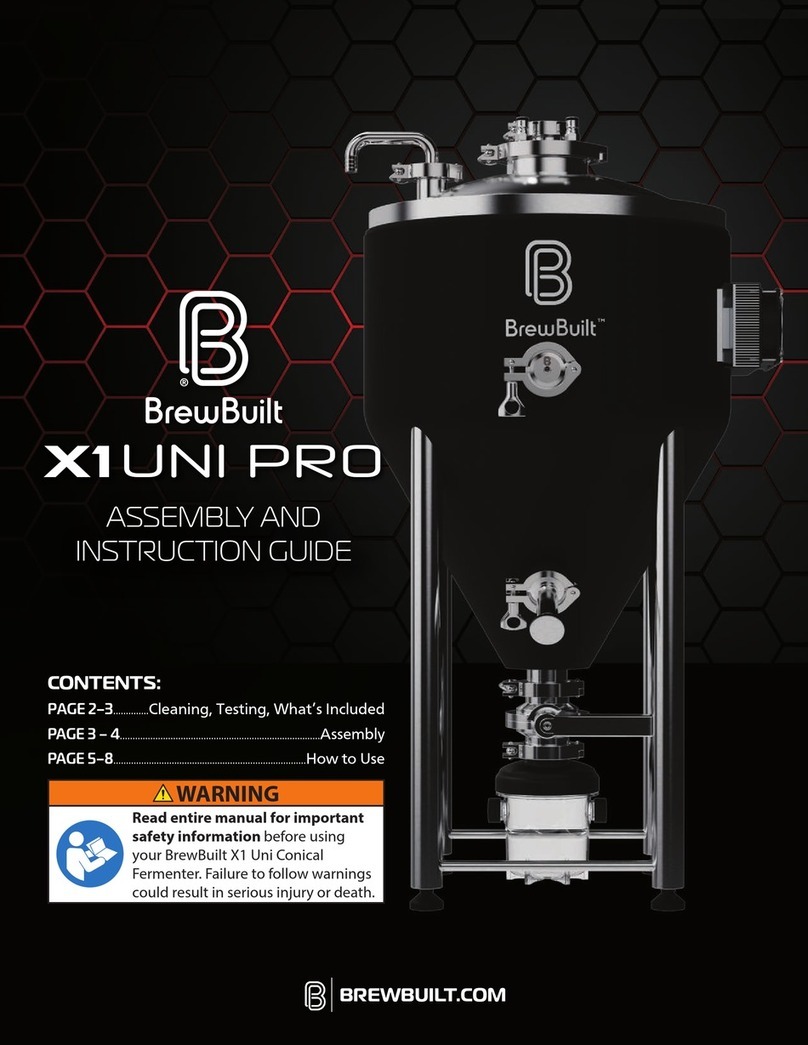
BrewBuilt
BrewBuilt X1 UNI PRO User manual

BrewBuilt
BrewBuilt X1 Uni Pro User manual
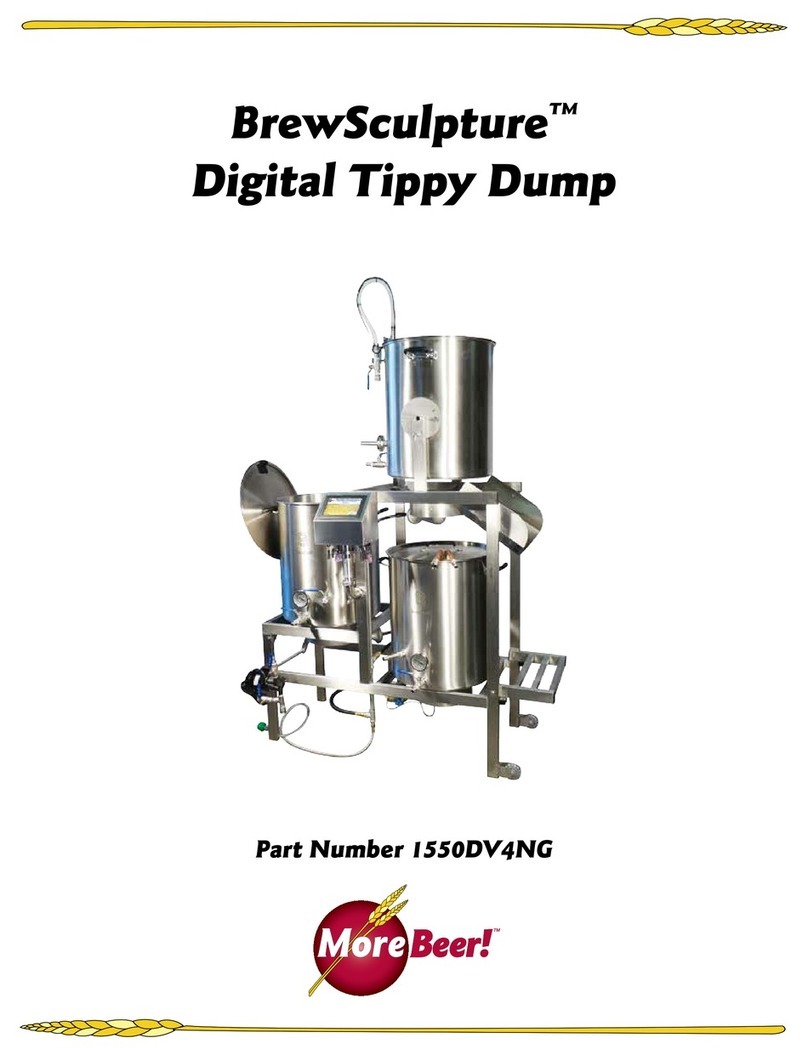
BrewBuilt
BrewBuilt BrewSculpture User manual
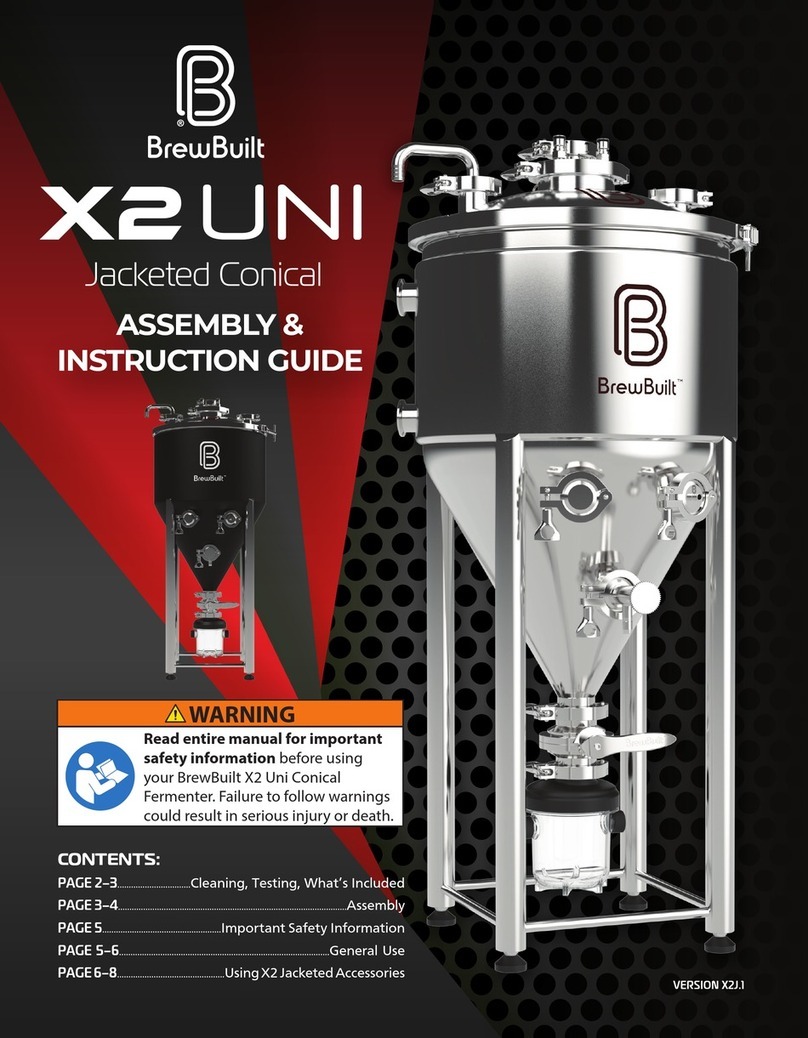
BrewBuilt
BrewBuilt X2 UNI User manual
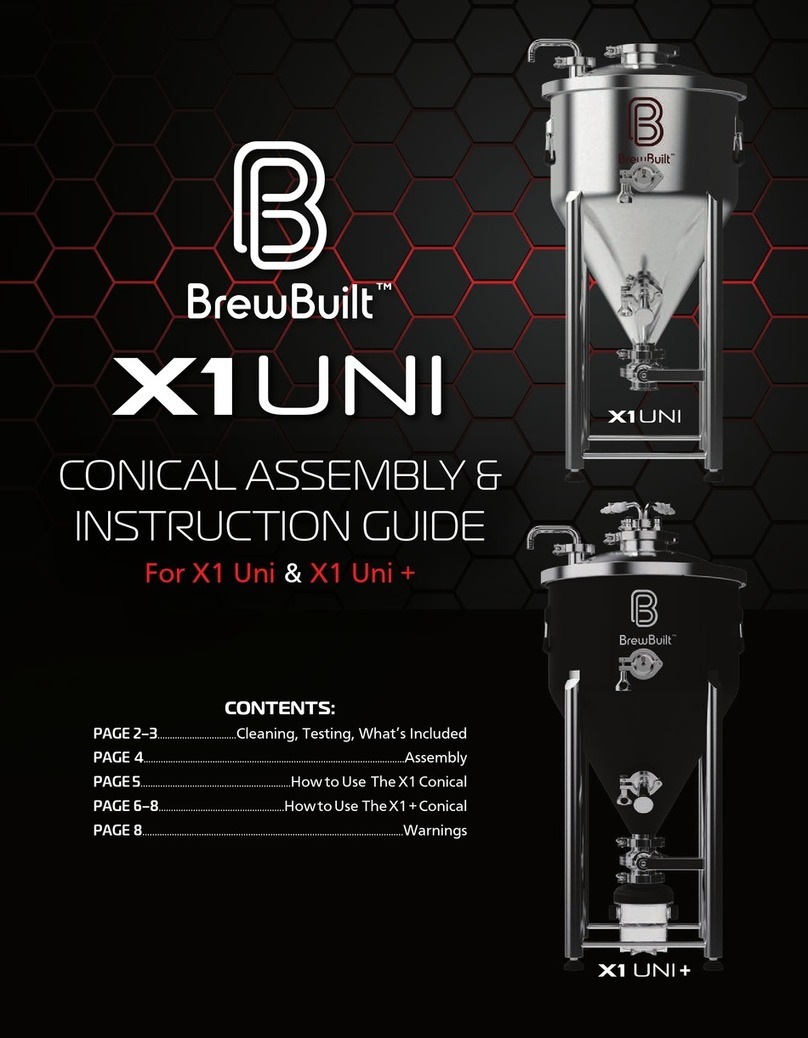
BrewBuilt
BrewBuilt X1 UNI User manual
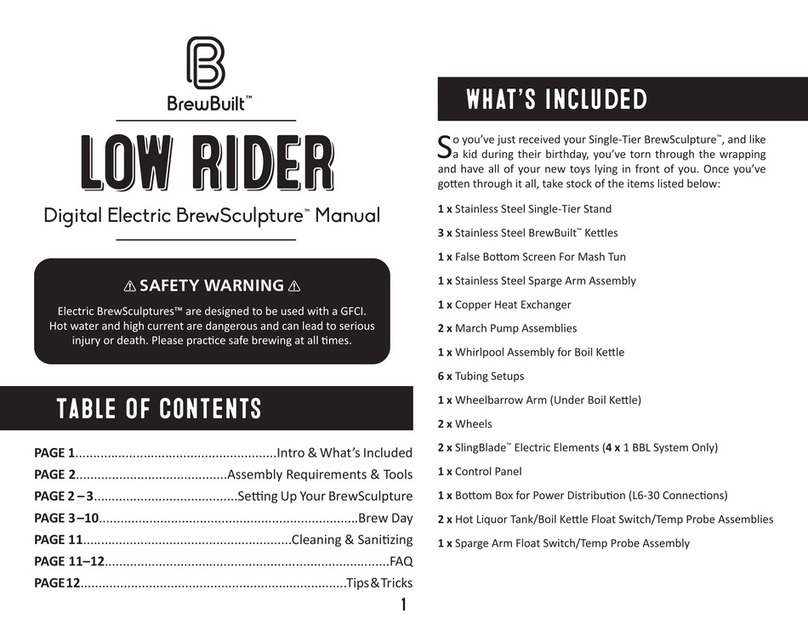
BrewBuilt
BrewBuilt BrewSculpture LOW RIDER User manual

BrewBuilt
BrewBuilt X1 Uni User manual

BrewBuilt
BrewBuilt X1 UNI User manual
Popular Brewing System manuals by other brands

BREWFERM
BREWFERM rvs 27 l operating instructions
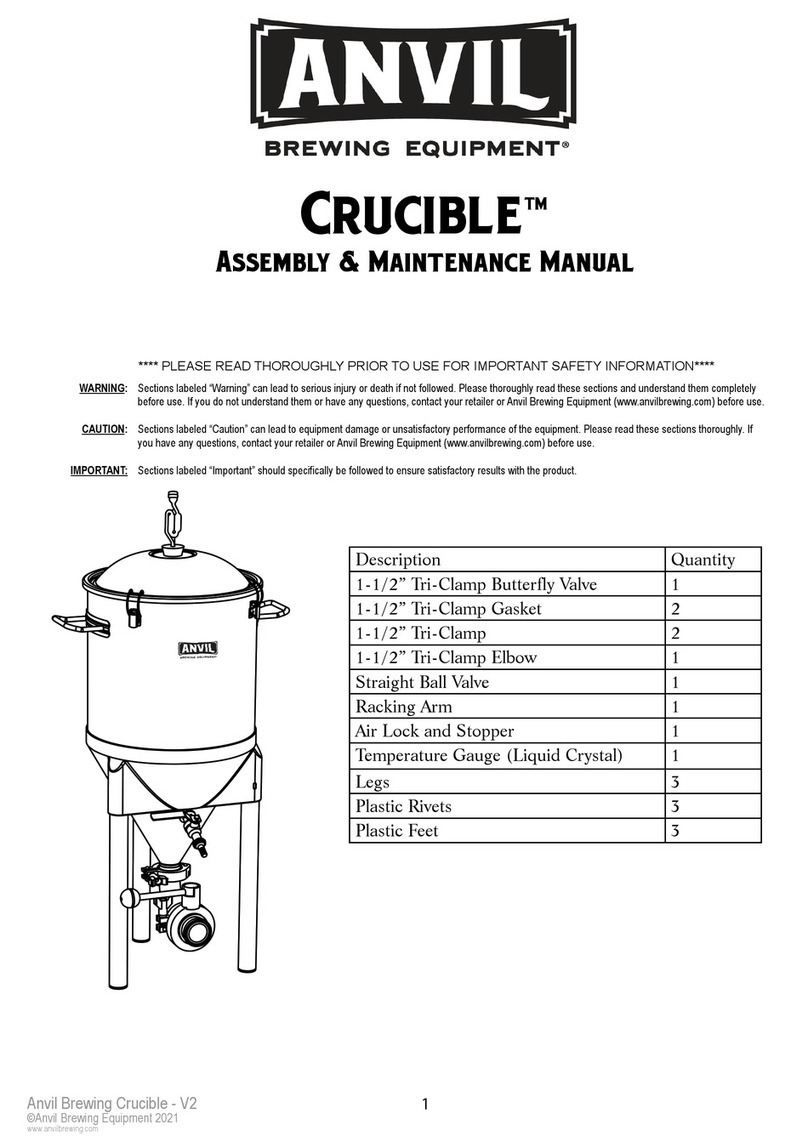
Anvil
Anvil Crucible Assembly & Maintenance Manual
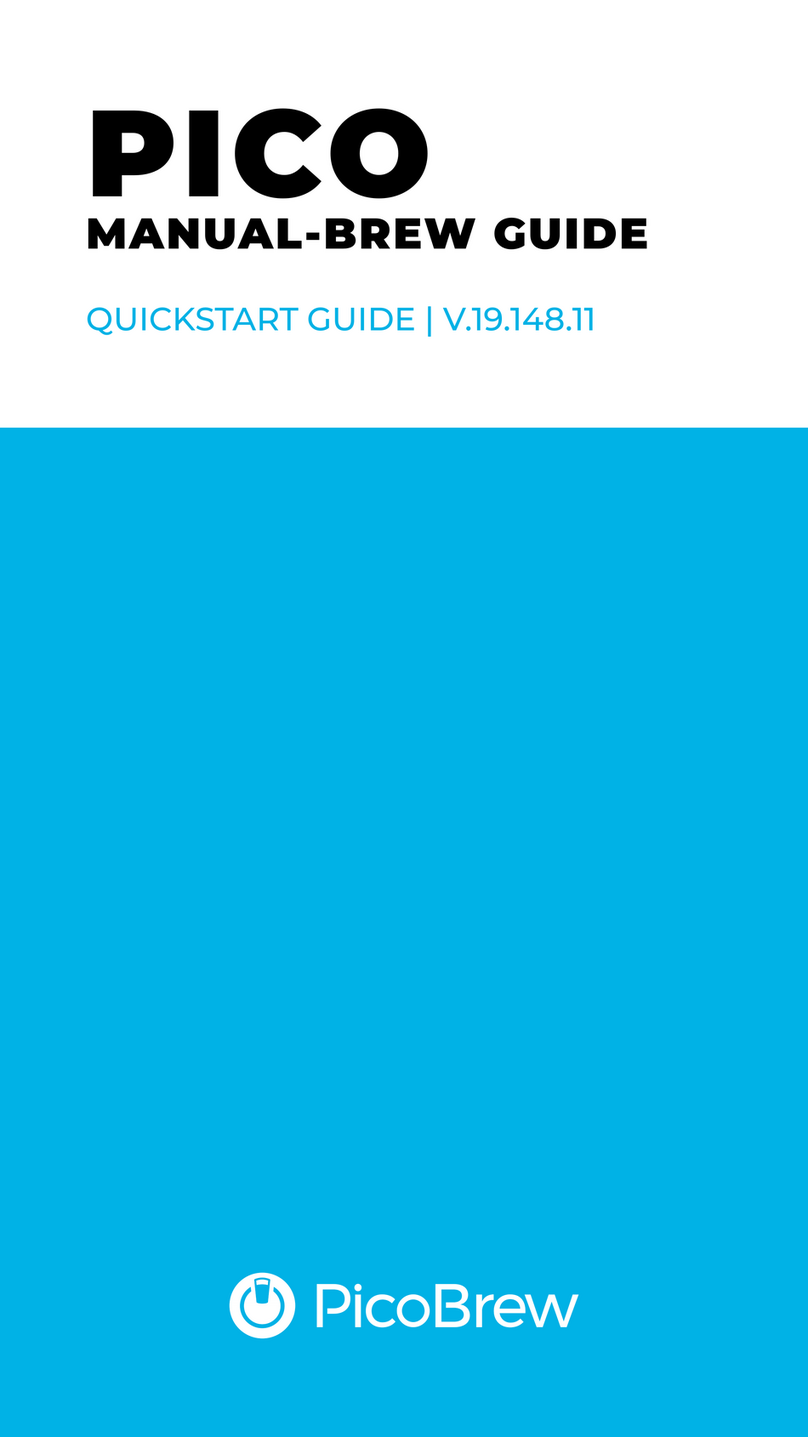
PicoBrew
PicoBrew Pico C quick start guide
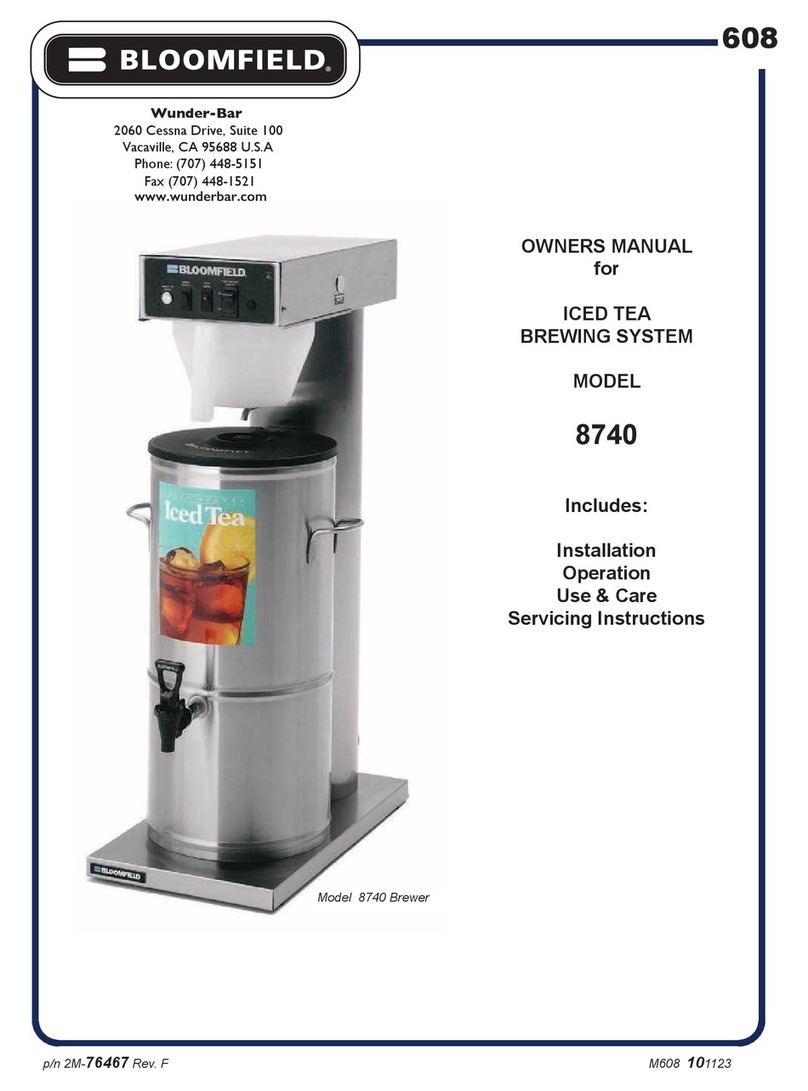
Bloomfield
Bloomfield 8740 owner's manual
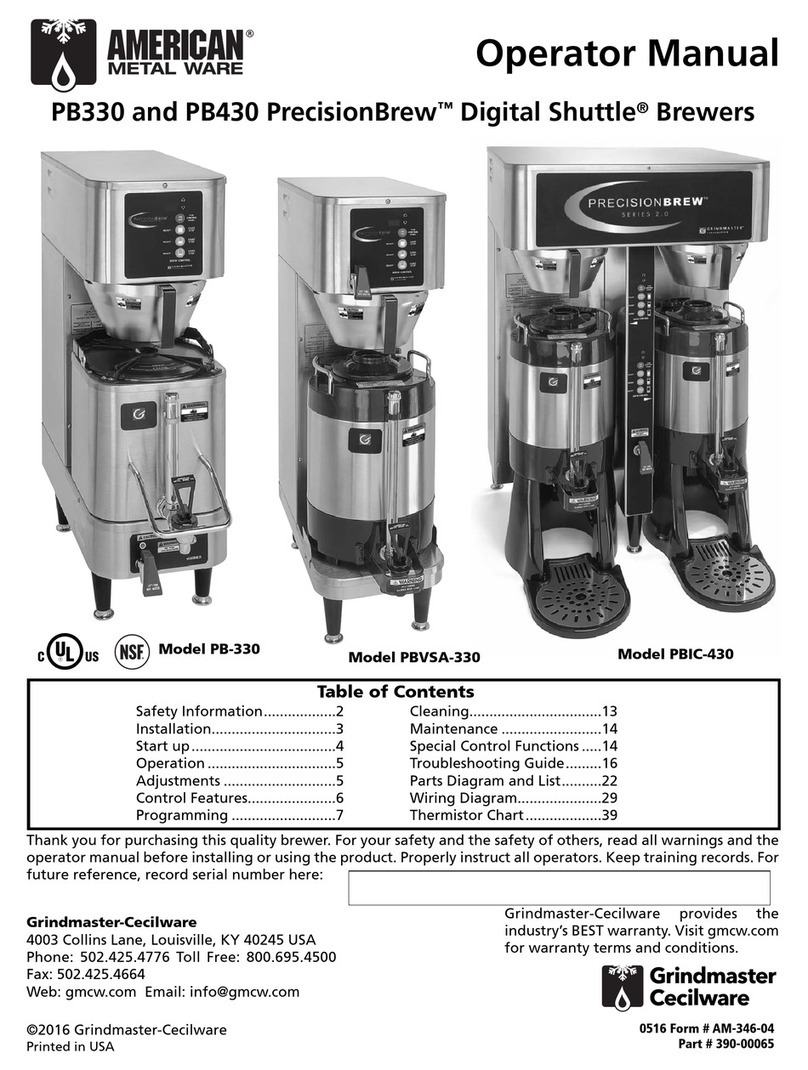
Grindmaster Cecilware
Grindmaster Cecilware American Metal Ware PrecisionBrew Digital Shuttle... Operator's manual
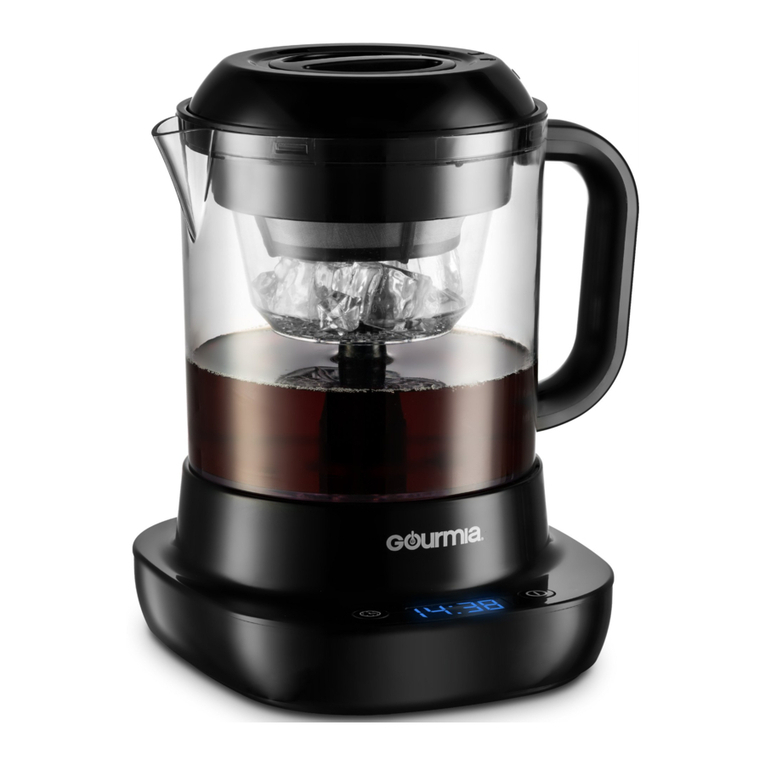
Gourmia
Gourmia GCM-6800 user manual
